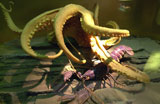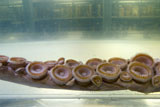Monsters of the deep
History is filled with tales of fearsome sea creatures from the deep ocean bothering passing ships. Descriptions of giant sea serpents feature in Norse mythology and Scandinavian folklore. Sea dragons and multi-armed beasts have been immortalised in many legends.
Some of these accounts are undoubtedly based on sailors confusing whales, sharks, other large fish or even tree trunks for mysterious monsters. But some real deep sea giants do exist.
The oarfish

The oarfish, Regalecus glesne
The oarfish has a flattened, snake-like body that grows up to almost 10m long. It has a bright red dorsal fin and a crest of long stiff rods, or fin-rays, on the top of its head.
This strange and harmless fish is seen occasionally at the surface and may even be washed on to the shore. Because we see it so rarely, little is known about the oarfish's lifestyle. Its stomach contents reveal that it feeds mainly on tiny animals that drift through the water.
Oarfish occasionally appear around Britain and one was caught by an angler in Yorkshire a few years ago. Sadly it was eaten before the Natural History Museum could get to it.
Octopuses

Common octopus, Octopus vulgaris
The largest real octopus is the giant pacific octopus, Octopus dolfleini. It is about 5m long and weighs 50kg, roughly the same as a small adult human. The legend of the giant octopus probably came from mistaken identity. It may have been confused with a giant or colossal squid that can grow up to 15m long.
Most octopuses live on the sea floor but one unusual deep sea group, the cirrate octopods, spend much of their time in mid-water. Their name comes from the small outgrowths on their arms, called cirri, which are thought to be sense organs for detecting other animals in the pitch black world at the bottom of the ocean.
Cirrate octopods do not have good vision but scientists have discovered that one species, Stauroteuthis syrtensis, emits blue-green bioluminescence from the suckers on its arms. This may be important for attracting prey.
The giant squid

The tentacle of a giant squid, Architeuthis dux
Because it lives in the deep sea, the giant squid, Architeuthis dux, is hardly ever caught by scientists or fishermen. We mostly know about the species from remains found in the stomachs of sperm whales, or from dead or dying specimens floating at the surface or washed up on to beaches. So we know a lot about the anatomy of the giant squid but little about its behaviour.
The giant squid has the largest eyes of any animal on Earth, up to about 30cm across, the size of a dinner plate. This suggests that it hunts its food where the natural light level is very low.
Discovering new species
There may be giants in the deep sea that we do not yet know about. In 1976, American scientists working in the Pacific hauled aboard a shark 4.5m long, previously unknown to science. It was named Megachasma pelagios meaning 'swimming big-mouth'. If such a large and relatively shallow-living fish could remain totally unknown for so long then the deep ocean may still hold many surprises.
Toolbox

The first collected specimen of Theobroma cacao, the plant from which chocolate is made, is kept in the Museum.
